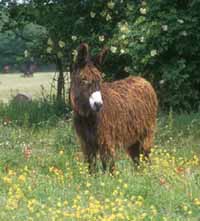|
The origins of the Poitou, as with many
ancient breeds, is a bit vague. It is said that the donkey and the practice
of mule breeding was introduced to the Poitou region of France by the
Romans. The two breeds, Poitou (donkey) and Mulassier (horse) seemed to have
been developed side by side for the sole purpose of producing mules of
exceptional quality. It is not known when the people of Poitou began
selecting for the type of mule-sire which we know today as the Poitou, but
evidence shows that the breed was already well established by 1717 when a
memoirs of the king's advisor described the donkeys of Poitou thus: "There
is found, in northern Poitou, donkeys which are as tall as large mules. They
are almost completely covered in hair a half-foot long with legs and joints
as large as a those of a carriage horse."
Up until the years following World War II, the Poitou played an important
roll in supplying quality mules to France and the rest of Europe. It is said
that the mule resulting from the union of a Poitou and a Mulassiere is the
finest working mule in the world. Whether this is indisputably true, we can
not say, but a Poitou mule, more often than not, fetches a higher price than
any other. It has been estimated that in the heyday of the industry, the
Poitou region produced as many as 30,000 mules per year.
After the war, mule production began to drop off. Tractors and automobiles
were replacing draft animals in every profession. Without a reason to
produce mules, there was little reason to raise Poitous. The decline of the
breed was swift. By 1977, only 44 donkeys of any age could be counted, held
by a few dedicated breeders. Fortunately, the cry was raised and efforts to
save the breed began. To day, there are perhaps as many as 180 purebred
Poitou Donkeys, but that number is still far from safety.
The Poitou is noted for its large size. The Andalucian ass is the only
other European breed of comparable size. Early breeders of these animals
selected for large ears, head and leg joints. The belief was that jacks with
these features would result in exceptionally large and strong mules. As a
result, the ears of some individuals of the Poitou are so large that they
are carried horizontal.
By standard, a Poitou should stand between
1.35 m and 1.50 m at the withers. His coat is black or brown with a grey
underbelly and a white nose and eye rings. A Poitou must never have a cross
upon his shoulders and back. The head is quite large and long, set on a
strong neck. The withers are unobtrusive and the back flat and long. The
croup is short and the haunches round. The limbs are strong with large
joints and loose movement. The feet of a Poitou are larger than those of
other donkey breeds and covered with the long hair of the legs. The ears
should be large and open, again, covered in long hair. The actual coat of a
Poitou Donkey is longer and softer than that of other donkey breeds. When
the animal is left ungroomed, it will often retain the long hair of its
youth which becomes matted and tangled, growing down into a great coat.
Tradition dictated that these animals with their great "cadenettes" were
most highly valued.
Changing attitudes in husbandry and hygiene finds many donkeys being
allowed to shed their great coats, but one can still find a few Poitous "bourailloux"
(with coats of great length).
Sources:
American Livestock Breeds Conservancy
Suzon Claire
|

